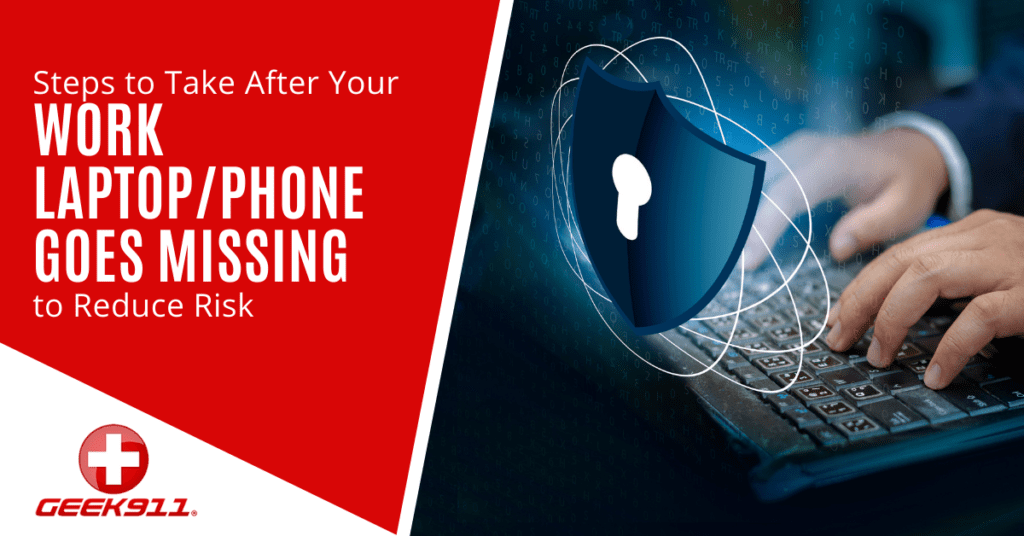Steps to Take After Your Work Laptop/Phone Go Missing to Reduce Risk

Something that can immediately make your stomach tie into knots is when you realize your smartphone or laptop has gone missing. Unfortunately, the same thing that makes mobile devices so popular, the fact that you can take them anywhere, also makes them more likely to be lost or stolen.
About 70 million smartphones are lost every year with only 7% of them being recovered. People often misplace devices or leave them behind in taxis and other public places. Devices are also stolen through business break-ins, car break-ins, and pickpockets.
Mobile devices are relied on heavily for business due to the rise in cloud technology and mobile business apps. Microsoft estimates that as much as 80% of workload is handled via smartphones and tablets.
The loss of a work device can cause major data security issues for companies. These can include:
- Business email compromise
- Breached cloud storage and other cloud accounts
- Phishing launched from the company’s domain
- Ransomware or other malware infection
- Data breach of customer or employee data
- Stolen company secrets
- Data privacy compliance violations
Beyond the immediate threat of a data breach, compliance violations for not protecting data that a lost device can access can be stiff. In 2020, a non-profit health system, Lifespan ACE, had to pay $1,040,000 due to the theft of an unencrypted laptop that exposed the health records of over 20,000 patients.
The moments after the device goes missing are the most critical, and the steps you take can make the difference between your personal data and your company data being breached or staying secure.
Here are things you should do as soon as you realize your work device has been lost or stolen:
Notify Your Company
Employees can be hesitant to notify their company of a missing business-use device if they fear getting in trouble, but it’s important to let your IT department or technology provider know as soon as possible.
If the company uses an endpoint device manager, then it can often quickly lock the device out of company resources and mitigate the damage. This could possibly ward off a potential data breach and compliance issue.
If Stolen, Make a Police Report
If you feel that the device is stolen, then make a police report. Having that official report can help if you are trying to make an insurance claim later for the device.
And while a vast majority of stolen smartphones and laptops are never recovered, there is a slim chance that the police crack a local theft case and recover stolen goods, in which case they will be able to match you as the owner of a found device.
Deauthorize the Device from Cloud Accounts
Laptops and mobile devices often are persistently logged in to things like cloud storage, Slack, and other types of business apps. You should open those apps from another device and look for the settings area that has a list of authorized devices.
Deauthorize and disconnect the device from the service. This will log the device out, and if a thief cannot easily log back in to gain access to your accounts.
Turn Off Autofill for Browser Passwords
Many people use the autofill feature in their internet browser to store passwords. But if a crook has your device, this gives them access to any accounts for which you’ve stored the password in this way.
You should log into your browser on another device and then look for the autofill feature in the settings and turn that off. At the same time, look for a section in your settings to deauthorize the device.
Activate “Lock My Device”
Many mobile devices have the ability to remotely control the device for some basic security tasks. In order for these to work, they need to be enabled, and the device needs to have location services (the GSP tracking) turned on.
If you have this set up, locking your device remotely can give you a bit more time to disconnect the device from cloud services while the hacker is going through a passcode hack to open your device.
Activate “Wipe My Device”
Hopefully, you’ve backed up your data and won’t lose everything on your phone once it’s stolen. If chances are low that you’ll ever see the device again, and you have the remote access activated, use the “wipe my device” feature to clear all data off your phone, tablet, or laptop.
Note, if you use a system like iCloud to store photos and videos, deauthorize the device from that system first (meaning, log the device out) before wiping it. Otherwise, the cloud syncing could cause all those images to also be deleted from iCloud storage.
Get Help Encrypting & Securing Your Mobile Devices
GEEK911 can help your Silicon Valley area business put mobile device security solutions in place, such as hard drive encryption, and more.
Schedule a consultation by calling 1-866-433-5411 or reach us online.
